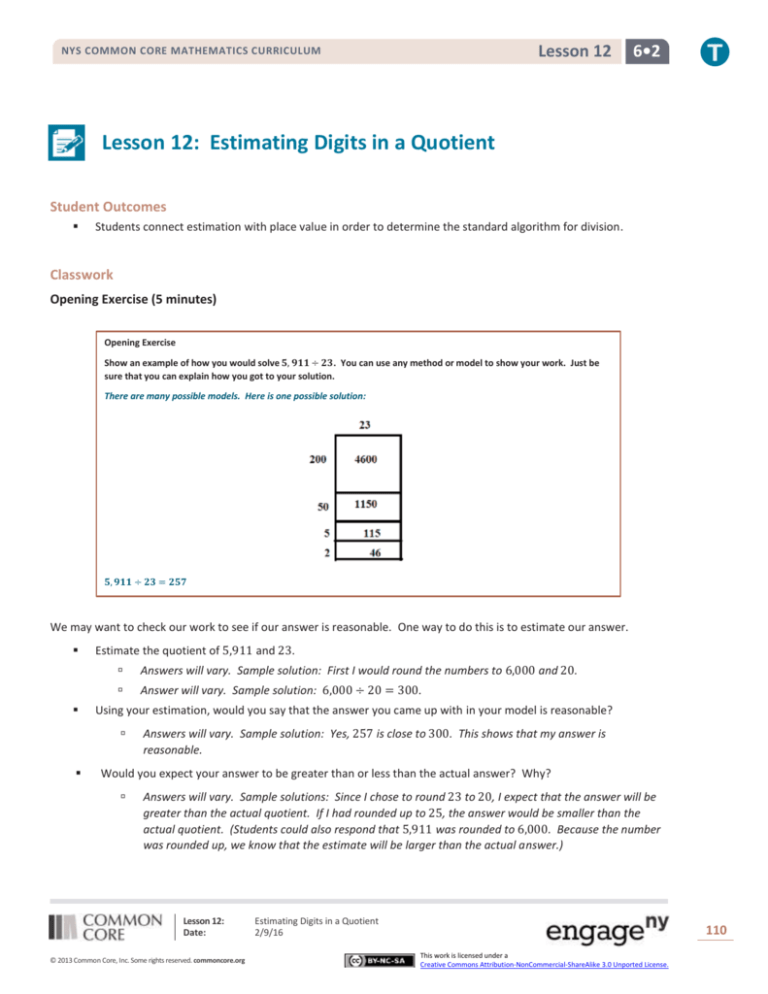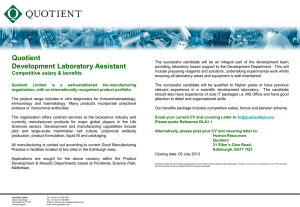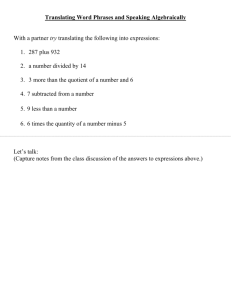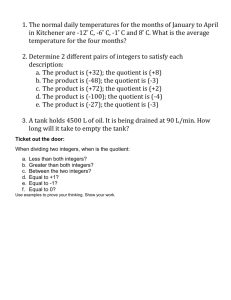
Lesson 12
NYS COMMON CORE MATHEMATICS CURRICULUM
6•2
Lesson 12: Estimating Digits in a Quotient
Student Outcomes
Students connect estimation with place value in order to determine the standard algorithm for division.
Classwork
Opening Exercise (5 minutes)
Opening Exercise
Show an example of how you would solve 𝟓, 𝟗𝟏𝟏 ÷ 𝟐𝟑. You can use any method or model to show your work. Just be
sure that you can explain how you got to your solution.
There are many possible models. Here is one possible solution:
𝟓, 𝟗𝟏𝟏 ÷ 𝟐𝟑 = 𝟐𝟓𝟕
We may want to check our work to see if our answer is reasonable. One way to do this is to estimate our answer.
Estimate the quotient of 5,911 and 23.
Answers will vary. Sample solution: First I would round the numbers to 6,000 and 20.
Answer will vary. Sample solution: 6,000 ÷ 20 = 300.
Using your estimation, would you say that the answer you came up with in your model is reasonable?
Answers will vary. Sample solution: Yes, 257 is close to 300. This shows that my answer is
reasonable.
Would you expect your answer to be greater than or less than the actual answer? Why?
Answers will vary. Sample solutions: Since I chose to round 23 to 20, I expect that the answer will be
greater than the actual quotient. If I had rounded up to 25, the answer would be smaller than the
actual quotient. (Students could also respond that 5,911 was rounded to 6,000. Because the number
was rounded up, we know that the estimate will be larger than the actual answer.)
Lesson 12:
Date:
© 2013 Common Core, Inc. Some rights reserved. commoncore.org
Estimating Digits in a Quotient
2/9/16
110
This work is licensed under a
Creative Commons Attribution-NonCommercial-ShareAlike 3.0 Unported License.
Lesson 12
NYS COMMON CORE MATHEMATICS CURRICULUM
6•2
What other ways can we check our solution?
I can use the inverse of division (multiplication) to check my work.
257 × 23 = 5,911
Example 1 (10 minutes)
Example 1
We can also use estimates before we divide to help us solve division problems. In this lesson we will be using estimation
to help us divide two numbers using the division algorithm.
Estimate the quotient of 𝟖, 𝟎𝟖𝟓 ÷ 𝟑𝟑. Then divide.
𝟖, 𝟏𝟎𝟎 ÷ 𝟑𝟎 = 𝟐𝟕𝟎.
How could I round these numbers to get an estimate?
Why is 8,100 and 30 the best option?
There are many possible solutions. Here are an example of some responses: 8,000 ÷ 30, 8,000 ÷ 35,
8,100 ÷ 30, 8,100 ÷ 35.
3 is not a factor of 8, but it is a factor of 81.
How can we use this to help us divide 8,085 and 33?
When I begin to divide, I use 270 to help me choose what numbers to divide by. My actual answer
should be near 270. The first number I used in my area model will be 200. Then I will see that the
remainder is 1,485. I know that 30 × 50 = 1,500, which is too big. So I will choose one less ten and
try 40.
MP.8
Create a model to show the division of 𝟖, 𝟎𝟖𝟓 and 𝟑𝟑.
We can keep track of the areas in the model and what we have left by making a list and subtracting. We will
create a list to keep track of the amounts the same way we created the diagram.
Lesson 12:
Date:
© 2013 Common Core, Inc. Some rights reserved. commoncore.org
Estimating Digits in a Quotient
2/9/16
111
This work is licensed under a
Creative Commons Attribution-NonCommercial-ShareAlike 3.0 Unported License.
Lesson 12
NYS COMMON CORE MATHEMATICS CURRICULUM
6•2
Now we can relate this model to the standard division algorithm.
At this point, you are just showing how this work is the same as the work that is shown in the model.
What does the 2 represent on top of the division bar?
How did we use the 200 in the previous model?
We divided 148 tens by 33, so the 4 represents 4 tens.
How was the 40 used in the previous model?
MP.8
33 × 200 = 6,600.
What does the 4 represent in the division bar?
We divided 80 hundreds by 33, so the 2 represents 2 hundreds.
33 × 40 = 1,320.
Now let’s check our division. How can we use the quotient to check our work?
245 × 33 = 8,085.
Example 2 (10 minutes)
Example 2
Use estimation and the standard algorithm to divide.
𝟏, 𝟓𝟏𝟐 ÷ 𝟐𝟕
Students will estimate the quotient first and use the estimate to help them divide using the algorithm.
Share an estimate that can be used to help us divide.
Answers may vary. 1,500 ÷ 30 = 50.
In the algorithm, we can show that there are fifty 27s by placing a 5 over the tens place. We know that 5 tens is
50. This is really showing that 151 tens ÷ 27 = 5 tens.
Lesson 12:
Date:
© 2013 Common Core, Inc. Some rights reserved. commoncore.org
Estimating Digits in a Quotient
2/9/16
112
This work is licensed under a
Creative Commons Attribution-NonCommercial-ShareAlike 3.0 Unported License.
Lesson 12
NYS COMMON CORE MATHEMATICS CURRICULUM
6•2
What would typically be the next step if you were creating a model? (Students can create the model while
solving to further solidify the connection.)
I would multiply 50 × 27, which is 1,350. Then I would subtract 1,350 from 1,512.
We will show these same steps in the algorithm.
MP.8
What would we do next?
162 ones ÷ 27. I know that 30 × 5 is 150. So I am going to estimate that the answer is bigger than 5.
Maybe there are six 27s in 162.
We will show the same steps again where we check our work by multiplying and subtracting.
Finally, we will check our work. Remind me one more time how we can check our quotient.
We can multiply 27 × 56 and see if the product is 1,512.
Exercises 1–4 (10 minutes)
Exercises
1.
𝟏, 𝟎𝟎𝟖 ÷ 𝟒𝟖
a.
Estimate the quotient.
𝟏, 𝟎𝟎𝟎 ÷ 𝟓𝟎 = 𝟐𝟎
Lesson 12:
Date:
© 2013 Common Core, Inc. Some rights reserved. commoncore.org
Estimating Digits in a Quotient
2/9/16
113
This work is licensed under a
Creative Commons Attribution-NonCommercial-ShareAlike 3.0 Unported License.
NYS COMMON CORE MATHEMATICS CURRICULUM
Lesson 12
b.
Use the algorithm to divide. Draw a model to show how the steps relate to the steps used in the algorithm.
c.
Check your work.
6•2
𝟒𝟖 × 𝟐𝟏 = 𝟏, 𝟎𝟎𝟖
2.
𝟐, 𝟓𝟎𝟖 ÷ 𝟑𝟑
a.
Estimate the quotient.
𝟐, 𝟒𝟎𝟎 ÷ 𝟑𝟎 = 𝟖𝟎
b.
Use the algorithm to divide. Draw a model to show how the steps relate to the steps used in the algorithm.
c.
Check your work.
𝟑𝟑 × 𝟕𝟔 = 𝟐, 𝟓𝟎𝟖
3.
𝟐, 𝟏𝟓𝟔 ÷ 𝟐𝟖
a.
Estimate the quotient.
𝟐, 𝟏𝟎𝟎 ÷ 𝟑𝟎 = 𝟕𝟎
b.
Use the algorithm to divide.
c.
Check your work.
𝟐𝟖 × 𝟕𝟕 = 𝟐, 𝟏𝟓𝟔
Lesson 12:
Date:
© 2013 Common Core, Inc. Some rights reserved. commoncore.org
Estimating Digits in a Quotient
2/9/16
114
This work is licensed under a
Creative Commons Attribution-NonCommercial-ShareAlike 3.0 Unported License.
Lesson 12
NYS COMMON CORE MATHEMATICS CURRICULUM
6•2
𝟒, 𝟕𝟑𝟐 ÷ 𝟓𝟐
4.
a.
Estimate the quotient.
𝟓, 𝟎𝟎𝟎 ÷ 𝟓𝟎 = 𝟏𝟎𝟎
b.
Use the algorithm to divide.
c.
Check your work.
𝟓𝟐 × 𝟗𝟏 = 𝟒, 𝟕𝟑𝟐
Closing (5 minutes)
How does estimation help you with the process of finding the exact quotient?
In the previous problem we used 100 to approximate the quotient 4,732 ÷ 52. How did we know that our
actual quotient would be in the 90s and not 100 as our approximation suggested? When using your estimate,
how do you know if your estimate is too big?
My estimate gives me an idea of what number my answer should be close to. For example, if I have an
estimate of 75, I know not to try a number in the hundreds.
I know that 100 × 52 = 5,200 and this is greater than 4,732. This tells me to start with a 9 in the tens
place.
When using your estimate, how do you know if your estimate is too small?
When I subtract, the difference is bigger than the divisor.
Exit Ticket (5 minutes)
Lesson 12:
Date:
© 2013 Common Core, Inc. Some rights reserved. commoncore.org
Estimating Digits in a Quotient
2/9/16
115
This work is licensed under a
Creative Commons Attribution-NonCommercial-ShareAlike 3.0 Unported License.
Lesson 12
NYS COMMON CORE MATHEMATICS CURRICULUM
Name ___________________________________________________
6•2
Date____________________
Lesson 12: Estimating Digits in a Quotient
Exit Ticket
1.
Estimate the quotient: 1,908 ÷ 36.
2.
Use the division algorithm and your estimate to find the quotient: 1,908 ÷ 36.
3.
Use estimation to determine if 8,580 ÷ 78 has a quotient in the 10s, 100s, or 1000s.
Lesson 12:
Date:
© 2013 Common Core, Inc. Some rights reserved. commoncore.org
Estimating Digits in a Quotient
2/9/16
116
This work is licensed under a
Creative Commons Attribution-NonCommercial-ShareAlike 3.0 Unported License.
Lesson 12
NYS COMMON CORE MATHEMATICS CURRICULUM
6•2
Exit Ticket Sample Solutions
1.
Estimate the quotient: 𝟏, 𝟗𝟎𝟖 ÷ 𝟑𝟔.
𝟐, 𝟎𝟎𝟎 ÷ 𝟒𝟎 = 𝟓𝟎
2.
Use the division algorithm and your estimate to find the quotient: 𝟏, 𝟗𝟎𝟖 ÷ 𝟑𝟔.
3.
Use estimation to determine if 𝟖, 𝟓𝟖𝟎 ÷ 𝟕𝟖 has a quotient in the 𝟏𝟎s, 𝟏𝟎𝟎s, or 𝟏𝟎𝟎𝟎s.
I would round 𝟖, 𝟓𝟖𝟎 to 𝟖, 𝟖𝟎𝟎 and 𝟕𝟖 to 𝟖𝟎. 𝟖, 𝟖𝟎𝟎 ÷ 𝟖𝟎 = 𝟏𝟏𝟎. I know that the quotient should be in the 𝟏𝟎𝟎s.
Problem Set Sample Solutions
Complete the following steps for each problem:
1.
a.
Estimate the quotient.
b.
Use the division algorithm to solve.
c.
Show a model that supports your work with the division algorithm.
d.
Be sure to check your work.
𝟑, 𝟑𝟏𝟐 ÷ 𝟒𝟖
𝟑, 𝟓𝟎𝟎 ÷ 𝟓𝟎 = 𝟕𝟎
𝟒𝟖 × 𝟔𝟗 = 𝟑, 𝟑𝟏𝟐
Lesson 12:
Date:
© 2013 Common Core, Inc. Some rights reserved. commoncore.org
Estimating Digits in a Quotient
2/9/16
117
This work is licensed under a
Creative Commons Attribution-NonCommercial-ShareAlike 3.0 Unported License.
NYS COMMON CORE MATHEMATICS CURRICULUM
2.
Lesson 12
6•2
𝟑, 𝟏𝟐𝟓 ÷ 𝟐𝟓
𝟑, 𝟎𝟎𝟎 ÷ 𝟑𝟎 = 𝟏𝟎𝟎
𝟐𝟓 × 𝟏𝟐𝟓 = 𝟑, 𝟏𝟐𝟓
3.
𝟏, 𝟑𝟒𝟒 ÷ 𝟏𝟒
𝟏, 𝟒𝟎𝟎 ÷ 𝟏𝟒 = 𝟏𝟎𝟎
𝟏𝟒 × 𝟗𝟔 = 𝟏, 𝟑𝟒𝟒
Lesson 12:
Date:
© 2013 Common Core, Inc. Some rights reserved. commoncore.org
Estimating Digits in a Quotient
2/9/16
118
This work is licensed under a
Creative Commons Attribution-NonCommercial-ShareAlike 3.0 Unported License.










